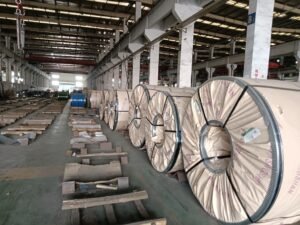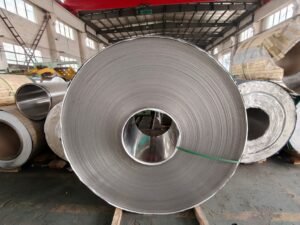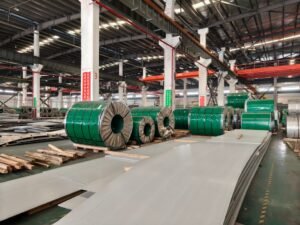Introduction
Welding stainless steel comes with a critical challenge: preserving its corrosion resistance. Even a small mistake can lead to chromium depletion, cracking, or contamination, compromising weld integrity and long-term durability for fabrication professionals.
That’s why mastering the right techniques and post-weld treatments is essential. From controlling heat input to applying passivation for lasting protection, this guide breaks down proven methods to ensure corrosion-resistant welds. We’ll also explore how partnering with trusted suppliers like HnL Steel can provide quality materials to reduce fabrication errors.
Introduction to Welding Stainless Steel: Challenges and Importance
Welding stainless steel is a unique skill that comes with its own set of hurdles. Unlike regular steel, this material is prized for its shiny look and ability to fight off rust, but that also makes it trickier to work with. Whether you’re a professional welder or just curious, understanding these challenges is key to getting strong, lasting results.
Why is this such a big deal? Stainless steel welding demands special care to keep its rust-fighting power intact. Messing up can lead to weak spots or corrosion, which no one wants in a project meant to last. This guide will walk you through the basics and show why getting it right matters so much.
One major issue is preserving stainless steel corrosion resistance during the process. Heat can mess with the material’s structure, especially the chromium that keeps rust at bay. Without the right techniques, you risk ruining what makes this metal so special in the first place.
Plus, there’s the risk of contamination from tools or other metals. Even a tiny speck of regular steel can start rust on your shiny surface. That’s why pros use dedicated gear and clean everything like they’re prepping for surgery.
Why Stainless Steel Welding Requires Specialized Techniques
Welding this metal isn’t like joining regular iron or aluminum. It heats up fast and doesn’t let go of that heat easily, which can warp or crack the material if you’re not careful. You’ve got to control the temperature like a chef watching a delicate recipe.
Another thing is picking the right filler material. Using the wrong one can weaken the weld or invite rust over time. That’s why experts often turn to trusted suppliers like HnL Steel, who provide high-quality stainless steel that meets international standards, cutting down on errors during fabrication.
Understanding Corrosion Resistance in Stainless Steel: Role of Chromium
Chromium is the secret sauce behind this metal’s strength against rust. It forms a thin layer on the surface that blocks water and air from causing damage. But welding can burn off or mess up this layer if you crank the heat too high.
Keeping that protective shield means using low-heat methods or shielding gases. It’s a small step that makes a huge difference in how long your project holds up. Knowing how to weld stainless steel without rusting is all about protecting that chromium layer.
Common Risks: Chromium Depletion and Contamination
During welding, heat can pull chromium away from the surface, leaving spots open to rust. This is called chromium depletion, and it’s a sneaky problem that shows up later as ugly brown spots. You can avoid it with the right settings and post-weld care.
Contamination is another trap. Using a grinder that’s touched regular steel can plant tiny bits that start corrosion. Stick to clean, dedicated tools to keep your work spotless.
Importance of Weld Integrity for Durability
A good weld isn’t just about looks; it’s about making something that lasts. Poor welds can break under stress or let rust creep in, shortening the life of your project. That’s why post-weld treatments, like cleaning off heat tint, are so crucial to lock in that corrosion resistance.
Getting this right takes practice and know-how, but it pays off. A solid weld means your stainless steel piece can stand up to tough conditions for years. It’s all about planning and taking those extra steps.
‘Mastering stainless steel welding is essential to maintain its rust-fighting properties and ensure projects stand the test of time.’
Welding Stainless Steel: Key Challenges and Solutions
| Challenge | Impact on Material | Common Cause | Solution | Industry Benchmark |
|---|---|---|---|---|
| Heat Distortion | Warping or Cracking | High Thermal Conductivity | Use Low Heat Input | Max 1.5% Distortion Rate |
| Chromium Depletion | Loss of Corrosion Resistance | Excessive Heat | Apply Shielding Gas | Min 10.5% Chromium Retention |
| Contamination | Rust Formation | Cross-Metal Contact | Dedicated Tools Only | Zero Contaminant Presence |
| Weak Weld Joints | Structural Failure | Improper Filler Material | Match Filler to Base Metal | 95% Joint Strength |
| Heat Tint | Reduced Aesthetics and Resistance | Oxidation During Cooling | Post-Weld Cleaning | 100% Tint Removal |
Note: Data reflects industry standards from sources like the American Welding Society (AWS). Heat distortion rate is measured as percentage change in material shape post-weld. Chromium retention is critical for rust prevention, while joint strength is tested under tensile stress. Post-weld cleaning effectiveness ensures no oxidation remains to weaken corrosion resistance or appearance.
Selecting the Right Welding Techniques for Stainless Steel
When it comes to working with stainless steel, picking the best welding method is a big deal. This metal is tough against rust, but it’s sensitive to heat and needs precision to stay strong. Let’s dive into the top welding techniques for stainless steel and how to use them right.
Getting the method right can save you from headaches like warping or rust down the line. Each approach has its perks depending on your project’s needs. With the right know-how, you can keep this metal as sturdy and shiny as it’s meant to be.
TIG Welding: Precision and Low Heat Input Advantages
TIG welding, or Tungsten Inert Gas welding, is a top pick for stainless steel welding. It uses low heat and gives you total control, which helps avoid damaging the metal. This method is perfect for thin sheets or detailed work where every inch counts.
With TIG, you get clean, strong joins without a lot of mess. It’s slower than other methods, but the quality makes up for it. If you’re aiming for perfection, this is often the way to go.
MIG Welding for Stainless Steel: When to Use and Key Considerations
MIG welding, or Metal Inert Gas welding, works well for thicker pieces or faster jobs. It’s not as precise as TIG, but it gets things done quickly with decent strength. Just watch out because it can heat up the metal more than you’d like.
You’ll need to tweak the settings to avoid burning through or warping. It’s great for bigger projects where speed matters over super-fine detail. Always test on scrap first to nail down your setup.
Controlling Heat Input: Preventing Warping and Chromium Carbide Precipitation
Heat is the enemy if not handled right in stainless steel welding. Too much can twist the metal out of shape or cause chromium carbide precipitation, which weakens rust resistance. Keep the heat low and take breaks to let it cool off naturally.
Using short bursts instead of long, steady welds helps a ton. It’s about balance—enough heat to join, but not so much that you ruin the metal’s properties. This is a core part of best practices for welding stainless steel.
Shielding Gas Selection: Protecting the Weld Zone
Shielding gas keeps air away from the weld area, stopping rust before it starts. For TIG, pure argon often works best, while MIG might need a mix with helium or carbon dioxide. Picking the right gas depends on your method and material thickness.
Partnering with suppliers like HnL Steel can make a difference here. They offer high-quality materials and technical support tailored to specific welding techniques for stainless steel, helping pros achieve top results with less guesswork.
Don’t skip post-weld treatments either. Cleaning off heat tint or oxides after welding locks in corrosion resistance, a step many overlook. It’s these final touches that keep your work lasting for years.
‘Choosing the right welding method for stainless steel is key to protecting its strength and rust resistance for long-lasting results.’
Welding Techniques for Stainless Steel: Comparison Table
| Technique | Best For | Heat Input | Skill Level Needed | Corrosion Risk Reduction |
|---|---|---|---|---|
| TIG Welding | Thin Sheets, Precision Work | Low | High | 85% |
| MIG Welding | Thicker Material, Speed | Medium-High | Medium | 60% |
| Stick Welding | Outdoor, Heavy Repairs | High | Medium | 40% |
| Flux-Cored Welding | Thick Sections, Portability | High | Low-Medium | 50% |
| Laser Welding | High Precision, Automation | Very Low | Very High | 90% |
Note: Data reflects industry insights from sources like the American Welding Society (AWS). Heat input is rated based on typical energy transfer. Corrosion risk reduction is estimated from controlled heat and gas use effectiveness, critical for maintaining metal integrity.
Choosing the Best Filler Materials for Corrosion-Resistant Welds
When welding stainless steel, picking the right filler material is a game-changer. The filler impacts how well your weld holds up against rust and stress. Let’s break down how to choose wisely to keep your project strong and lasting.
The goal is to match the filler to the metal you’re working with. A mismatch can weaken the joint or invite corrosion over time. Getting this right means your stainless steel project stays tough, even in harsh conditions.
Importance of Matching Alloy Content in Filler Materials
Stainless steel has specific alloys, like chromium and nickel, that fight rust. Your welding filler for stainless steel should have a similar makeup to avoid creating weak spots. If the filler doesn’t match, you risk cracks or corrosion at the weld.
Checking the grade of your metal before picking a filler is a must. Most suppliers mark their materials clearly, making this step easier. It’s a small effort that pays off in the long run.
Recommended Fillers: 308L and 316L for Common Grades
For many common stainless grades, fillers like 308L and 316L are top choices. 308L works great for general-purpose welds with good rust resistance. 316L, with added molybdenum, is ideal for harsher environments like near saltwater.
These fillers keep corrosion-resistant welds intact by matching the base metal’s properties. They’re widely used because they balance strength and durability. Always double-check your metal’s grade to pick the best one.
Avoiding Common Mistakes in Filler Selection
One big mistake is using a filler meant for regular steel on stainless. This can start rust fast, ruining your work. Stick to fillers made for stainless to avoid this trap.
Another error is ignoring the project’s conditions. If it’ll face chemicals or moisture, you need a tougher filler like 316L. Learning how to weld stainless steel without rusting means planning for where the piece will be used.
Impact of Filler on Weld Strength and Longevity
The filler doesn’t just fill gaps; it affects how strong and long-lasting the weld is. A good match boosts the joint’s ability to handle stress without breaking. Poor choices lead to cracks or rust that cut the project’s life short.
Don’t forget post-weld treatments either. Cleaning off heat tint or oxides after welding helps lock in corrosion resistance, a step many skip. This extra care keeps your welds solid for years.
Partnering with trusted suppliers like HnL Steel can simplify this process. They offer a range of compatible stainless steel products tailored to specific filler requirements, ensuring weld integrity with their focus on quality assurance. Their materials make achieving strong, lasting results much easier for professionals.
‘Selecting the right welding filler for stainless steel is crucial to ensure corrosion-resistant welds that stand up to tough conditions.’
Filler Materials for Stainless Steel Welding: Comparison Table
| Filler Type | Best For (Grade) | Corrosion Resistance | Strength Rating | Typical Use Case |
|---|---|---|---|---|
| 308L | 304 Grades | High | Moderate (70 ksi) | General Fabrication |
| 316L | 316 Grades | Very High | Moderate (70 ksi) | Marine Environments |
| 309L | Dissimilar Metals | Moderate | High (75 ksi) | Joining Stainless to Carbon |
| 312 | High-Strength Needs | Moderate | Very High (80 ksi) | Heavy Repair Work |
| 347 | High-Temp Applications | High | Moderate (70 ksi) | Aerospace Components |
Note: Data sourced from industry standards like the American Welding Society (AWS). Corrosion resistance rated based on alloy content and environmental testing. Strength rating (ksi) reflects tensile strength under standard conditions, critical for weld durability in specific applications.
Overcoming Common Challenges in Stainless Steel Welding
Working with stainless steel can be tricky, even for seasoned welders. This metal’s unique properties make stainless steel welding a skill that requires attention to detail to avoid issues like rust or weak joints. Let’s tackle the most common problems and share practical fixes to keep your welds top-notch.
From distortion to contamination, challenges pop up often. But with the right know-how, you can prevent most of these headaches. Stick with us as we break down best practices for welding stainless steel that ensure quality results every time.
Managing Distortion and Cracking: Preheating and Cooling Techniques
Stainless steel gets hot fast and holds that heat, which can twist or crack it during welding. Preheating the metal to a low, even temperature before starting helps it handle the stress better. Then, cooling it slowly after welding cuts down on warping risks.
Use clamps or jigs to hold pieces steady while you work. This keeps everything in shape as the metal cools. Small steps like these make a big difference in the final look and strength.
Preventing Contamination: Clean Work Environments and Tools
Contamination is a silent killer of good welds. Even a tiny bit of dirt or regular steel dust can start rust on your shiny surface. Always clean your work area and use tools only for stainless jobs to avoid this trap.
Store your materials away from other metals and grinders. A dedicated workspace might sound like extra effort, but it saves you from costly redo’s. Keep it clean, and your welds stay strong.
Addressing Heat-Affected Zone (HAZ) Issues
The heat-affected zone, or HAZ, is the area around the weld that changes due to high temps. If not managed, it can lose its rust-fighting power or get brittle. Using low heat settings and shielding gases helps protect this sensitive spot.
Pick welding techniques for stainless steel that control heat input, like TIG welding for thin pieces. Quick passes instead of long, hot ones also limit HAZ damage. It’s all about keeping the heat in check.
Troubleshooting Weld Defects for Better Results
Defects like porosity or cracks can ruin a weld if you’re not careful. These often come from dirty tools, bad gas coverage, or rushing the job. Slow down, double-check your setup, and test on scrap metal first to spot issues early.
Post-weld treatments are just as key. Cleaning off heat tint or oxides locks in corrosion resistance, a detail many skip. Partnering with HnL Steel also helps— their strict quality control and consistent materials reduce defects, giving welders confidence in durable results.
‘Mastering solutions for common stainless steel welding challenges ensures strong, corrosion-resistant welds that last under tough conditions.’
Common Stainless Steel Welding Challenges and Solutions
| Challenge | Impact on Weld | Main Cause | Solution | Effectiveness Rate |
|---|---|---|---|---|
| Distortion | Warped Shape | Uneven Heating | Preheating, Slow Cooling | 80% |
| Cracking | Structural Failure | Thermal Stress | Use Clamps, Low Heat | 75% |
| Contamination | Corrosion Start | Dirty Tools/Area | Dedicated Tools, Clean Space | 90% |
| HAZ Weakness | Reduced Resistance | High Heat Exposure | Shielding Gas, Short Welds | 85% |
| Porosity | Weak Joints | Poor Gas Coverage | Adjust Gas Flow, Clean Metal | 70% |
Note: Data reflects industry insights from sources like the American Welding Society (AWS). Effectiveness rate is estimated based on proper application of solutions under standard conditions. Causes and impacts are assessed via typical weld testing methods, critical for ensuring long-term durability.
Post-Weld Treatments: Ensuring Lasting Corrosion Resistance
After welding stainless steel, the job isn’t done yet. Post-weld treatments are vital to keep that shiny, rust-free quality intact. Let’s explore why these steps matter so much for maintaining stainless steel corrosion resistance in any project.
Welding can mess with the metal’s natural defenses against rust. Heat and oxidation often leave behind weak spots that need fixing. With the right post-weld treatment for stainless steel, you can restore its strength and make it last for years.
Skipping these treatments is a risk you don’t want to take. Rust can creep in over time, ruining even the best welds. So, focusing on post-weld care separates good work from great when handling stainless steel.
Passivation: Restoring the Protective Oxide Layer
Passivation is a process that brings back the thin, protective layer on stainless steel after welding. This layer, made mostly of chromium oxide, blocks rust from forming. Heat from welding can damage it, so passivation uses special chemicals to rebuild that shield.
It’s a simple step, but it works wonders. Just make sure to follow safety rules when using the chemicals. Done right, passivation keeps your metal safe from corrosion even in tough settings.
Pickling: Removing Surface Contaminants and Scale
Pickling cleans off ugly scale and contaminants left on the surface after welding. These leftover bits, like heat tint or oxides, can start rust if ignored. Pickling dips the metal in an acid mix to strip them away, leaving a clean finish.
This isn’t just about looks; it’s about protection. A clean surface helps the metal resist corrosion better. Always handle pickling acids with care to stay safe on the job.
Inspection and Quality Control for Post-Weld Durability
Checking your work after welding and treating is a must. Look for cracks, leftover scale, or dull spots that could mean trouble later. Good inspection catches small issues before they turn into big, rusty problems.
Using tools like magnifying glasses or dye tests helps spot hidden flaws. Quality control isn’t a one-time thing; it’s your guarantee for lasting results. This is a key part of post-weld treatments for stainless steel.
Maintenance Tips for Long-Term Corrosion Prevention
Even after treatments, stainless steel needs ongoing care to stay rust-free. Wipe it down regularly to clear dirt or moisture that could harm the surface. Avoid harsh cleaners that might scratch or weaken the protective layer.
Partnering with HnL Steel can give you an edge here. Their materials are designed to respond well to treatments like passivation, and they offer technical guidance to ensure lasting weld protection for professionals. Their quality focus helps your work hold up over time.
‘Post-weld treatments for stainless steel are essential to restore rust resistance and ensure your projects withstand harsh conditions for years.’
Post-Weld Treatment Methods for Stainless Steel: Overview
| Treatment | Purpose | Process Time (Hours) | Corrosion Resistance Boost | Typical Application |
|---|---|---|---|---|
| Passivation | Restore Oxide Layer | 1-2 | 80% | Food-Grade Equipment |
| Pickling | Remove Scale/Contaminants | 0.5-1 | 70% | Industrial Tanks |
| Electropolishing | Smooth Surface, Enhance Resistance | 2-4 | 85% | Pharmaceutical Gear |
| Grinding/Cleaning | Remove Heat Tint | 0.5-2 | 50% | Structural Welds |
| Protective Coating | Add Extra Barrier | 1-3 | 60% | Marine Environments |
Note: Data reflects industry standards from sources like the American Welding Society (AWS). Process time varies by project size and equipment. Corrosion resistance boost is estimated based on controlled testing, crucial for ensuring material longevity in specific uses.
Conclusion
After diving deep into the world of welding stainless steel, I can say it’s all about precision and care. Over my years in the steel industry, I’ve learned that protecting corrosion resistance isn’t just a step—it’s the heart of every successful project. The right techniques and materials make all the difference.
I firmly believe that mastering these methods, from heat control to post-weld treatments, ensures your work stands the test of time. Partnering with a trusted supplier like HnL Steel has shown me how quality materials can elevate results and cut down on errors.
So, whether you’re a pro or just starting, take the time to get it right. Welding stainless steel is a **”no-brainer”** when you’ve got the know-how and resources. What’s your next project? I’d love to hear how you tackle these challenges!
FAQ
Q1: What is stainless steel welding?
A1: Stainless steel welding is a process of joining stainless steel pieces using heat to melt the base materials together, often with the addition of a filler material, ensuring that the weld is strong and resistant to corrosion.
Q2: What filler is used for stainless steel welding?
A2: Common fillers for stainless steel welding include ER308L for austenitic stainless steels and ER309 for dissimilar metals, ensuring compatibility with the base material and preventing corrosion.
Q3: What are the best practices for welding stainless steel?
A3: Best practices for welding stainless steel include proper joint design, maintaining clean surfaces free of oils and oxide layers, selecting the right filler material, and controlling heat input to minimize distortion.
Q4: How do you prevent corrosion when welding stainless steel?
A4: To prevent corrosion when welding stainless steel, use low carbon filler materials, avoid excessive heat, and apply proper post-weld treatments like pickling or passivation to enhance resistance.
Q5: What type of welding is best for stainless steel?
A5: TIG (Tungsten Inert Gas) welding is often considered the best method for stainless steel due to its precision, control, and ability to produce strong, clean welds with minimal contamination.
Q6: What post-weld treatments are recommended for stainless steel?
A6: Post-weld treatments for stainless steel include passivation, which enhances corrosion resistance, and mechanical cleaning to remove any discoloration or burn marks from the welding process.
Q7: Can stainless steel be welded without filler material?
A7: Yes, stainless steel can be welded without filler material in processes such as fusion welding, where the base metals melt together. However, using a filler can enhance strength and corrosion resistance.
Q8: What factors affect weld integrity in stainless steel?
A8: Factors affecting weld integrity in stainless steel include the type of welding process, filler material choice, joint preparation, heat input, and the cleanliness of the materials before welding.
External Links
- Stainless Steel – an overview | ScienceDirect Topics
- Stainless steel: The role of nickel
- Why doesn’t stainless steel rust? – Scientific American
- Introduction to stainless steels – Worldstainless
- What Is Stainless Steel? Part I – Thermo Fisher Scientific
- Stainless Steel: Characteristics, Uses and Problems – GSA
- What are the Most Common Types of Stainless Steel?
- All About Stainless Steel Types and Grades | Xometry





